QuestionQUESTION: I just got a bearded dragon (sub adult) a few days ago and am not sure how they should sleep. This morning I found her curled up under her hiding rock and when I touched her she didn't move, so it scared me. So I picked her up and she woke up and grabbed my fingers and had her head up. Is this normal for them to do? I just want to know so I won't freak out all the time. My tank is kept at over 100 degrees on one side and 80 on the other. the basking light is on a timer. She ate 3 crickets yesterday and is eating her greens. She has only pooped once so far. Thanks for the help.
ANSWER: Hi Carrie,
I am going to include a basic care sheet that I wrote to help people out with caring for their beardies.
Temperatures are very important to the beardie. They do need to have certain temperature zones so that they are able to thermoregulate their bodies. Basically, they have 3 zones..the basking, the mid range and the cool area. Basking range is 95-105 gradient.. mid range is in mid to upper 80's and a cool area that is fine down into the 70's. During the night, they don't really need any heat unless the room is dropping down into the 60's, but I do recommend that they do have temps at night in the mid 70's.
UVB is very important to their health. They need to have a proper uvb source to be able to use the calcium in the foods they eat.
It is normal for them to be stressed for a week or so when moved into a new home. Sometimes we have to intervene and remove their hide during the day so that they are able to get the needed uvb and heat. They sometimes may hide because they can't find a cool spot..so be sure to check all your temperatures.
When your beardie saw your fingers, he most likely thought he was getting fed, or saw your fingers as an insect....but..she could have just been saying leave me alone, or..I am tough!!!
Try making sure she is awake and sees you before attempting to pick her up. OH!! and I want to give you a big THANK YOU for feeding greens!!!! So many people do not realize how much a part of their diet the greens are!! Great job!!
BASIC BEARDED DRAGON CARE:
HOUSING:
For an adult bearded Dragon, a 50 -55 gallon is the smallest recommended tank. For a baby, nothing less than a 30 gallon tank will work for a very short time, so its best to just start out with the adult sized tank....you can add rocks and branches for climbing, being sure to not stack rocks too high to prevent them toppling over. Branches need to be secure. They like to have a hide log or cave too!! All items brought from outside need to be cleaned well before placing them in the BD's tank. To clean them, there are a few methods: to wash in a bleach solution of 1/4 cup of bleach to 1 gallon of water. Let them soak for about an hour, rinse them in hot water several times and then let them dry in the sun until completely dry. If the items are small enough, they can be baked in an over at 200 degrees for about 2 hours, check often to be sure they are not starting to burn. The items can also be boiled(simmered) for 30 minutes or so and then allowed to dry completely before placing in the tank. I also suggest washing any pet store items such as caves, rocks, branches, etc before placing in the tank as that if the store would happen to have mites they can also be on the items we purchase. Any of the above methods are acceptable for cleaning. CAUTION!!! On store bought branches...be VERY careful with the driftwood pieces that have the holes in them!!! Be sure the holes are small as that if the holes are large, the BD MAY be able to get his head in them but not able to get it back out!!! A secure screen top is necessary for bearded dragons as that also they do not require much height for climbing..they can and do climb!! NEVER USE HEAT ROCKS OR HEATED CAVES!!! They malfunction and cause severe burns and even death!!!!
SUBSTRATES:
Young bearded dragons MUST be kept on paper towels, newspaper or other non particulate(loose) substrate to prevent them from getting any loose substrate into their mouth and swallowing it which can and does cause intestinal blockages.Once the BD is over 10 inches, some people have had good luck using play sand mixed with 50% of peat moss. I prefer the safe substrate of the newspaper, or other non particulate substrate to prevent any problems and also for ease of cleaning.
LIGHTING:
BD's need UVB, which is the special lights that come in fluorescent tubes or special screw in bulbs(mercury vapor)that are designed to produce uvb and heat. The tubes do not produce heat. UVB is needed by the BD to be able to absorb the calcium in the foods they eat. Without the uvb, they will develop metabolic bone disease. With the tubes, they must say that they produce BOTH uvb and uva. The uvb needs to be 5% or higher. Repti Sun 5.0 and 10.0(not compact) are TWO of the best uvb tubes on the market. The repti glo 8.0's are a great uvb source also. Arcadia 5.0 (UK), which is the uvb tube available in the UK is a good uvb tube. These need to be positioned 6-8 inches(for the 5.0 and 8.0 and 8-10 inches for the 10.0) over the BD so that they get the uvb that is needed. Recommended length of the tube is 24 inches or more. They need to be replaced every 6-9 months as that they stop producing uvb long before they stop producing light. They need to have access to uvb and basking
temperatures for 10-12 hours daily. At night, no white lights!!!
There has been new studies that have proven that compact uvb lights, both the spiral/coil type and the ones that look like long "U's" laying on their side and a few other brands are causing what basically amounts to snow blindness in reptiles. The companies have corrected the problem but, there may still be some of the earlier manufactured bulbs out there so be sure to double check what you are using, or even if you are using proper uvb source. To read more on this, you can go to
http://www.uvguide.co.uk/index.htm
There are tubes and bulbs that say ''full spectrum'' but they do not produce any uvb.
On the mercury vapor , they also produce heat. They also produce the uvb and uva. The best on the market now are the MEGA RAY. www.reptileuv.com has more information on the Mega Ray lights. When using these, the distance is much greater than the uvb tubes and the directions must be followed that are listed for the light. When using the mercury vapor lights, you don't need to have one light for uvb and one for heat. The Mercury vapor lights provide both.
HEATING AND TEMPERATURES:
Bearded Dragons have specific temperature requirements. For heat when using the uvb producing fluorescent tubes, a regular household light bulb will work for DAYTIME heat. The wattage needed will vary to each situation such as tank size, room temperatures, air flow. Their basking area temperature must be between 95F and 105F degrees to allow proper digestion of food. Your basking area must be where the uvb light is as well as the heat source. Be sure that the BD cannot get too close to the heat source as that they WILL get burned! The ambient temperature range in the mid 80's . Cool daytime range of normal room temperature of low to mid 70's. Nighttime temperatures in the low to mid 60's is fine. NEVER USE HEAT ROCKS!!!!!!!!!!!!!!!!!!!!! A good digital thermometer is a must. I like using the duel ones with the probe...cost about 15$ at Wal Mart. The probe can be placed in the basking area at the BD's level to monitor this temperature and the main unit can be pl
aced in one of the ambient temperature areas. When reading them, the "out" reading is the probe area.
DIET:
Bearded Dragons eat and need both animal proteins and vegetable matter!!! As young dragons they eat a bit more of the insects. As they get older, as adults their diet is more of the vegetable matter. As young BDs, the diet is about 80% animal proteins and 20% vegetable matter. As they get older, the ratio changes. An adult will eat about 80%-90% vegetable matter and 10-20% animal proteins.
Animal protein sources are: Crickets, superworms, silkworms, roaches, hornworms, waxworms. Waxworms are considered candy to a BD so only feed on occasion in a small amount(2-3 worms). ALL insects must be properly gutloaded for at least 48 hours prior to feeding to the dragon. For crickets and superworms, this can be done with vegetables, plain cereals and commercial foods for the species. Silkworms and the other insects have their own diet needs. Its best to feed the crickets in a separate feeding tank such as a 10 or 20 gallon size tank or container with a well vented lid. This can make it easier for the dragon to catch the crickets and prevents any stray crickets in their "home" tank from deciding to nibble on the BD if he happens to not find them all. If you do feed in his home tank, be sure to place a 1/2 potato in the tank to help prevent the crickets from biting at the BD. ALL insects fed must be no larger than the space between their eyes to prevent choking. Be
sure to dust the insects daily(for dragons up to 14-15 inches) (2x wkly there after)with a good calcium source such as Rep Cal calcium powder with no added Phosphorus. Young BD's up to 4 months of age will eat more crickets than anything. At this age they will usually consume anywhere from 10 to 30+ correctly sized crickets three times a day. Be sure to remove any uneaten crickets that are not consumed in a 15-25 minute time frame. For this reason, its easier to use a separate feeding tank for the bearded dragon. A 10 gallon tank(with a screen top) works well. Its best to offer their "salad" of greens/veggies before offering their morning insect feeding when they are hungry to prevent any problems with them preferring NOT to eat their salad. Their salad consists of Collard greens, mustard greens, turnip greens, dandelion greens...... this is the BASE of the green part of their vegetable diet. To this, for variety you can add arugula, escarole, endive,small amounts of
bok choy or other Asian greens. For the vegetable part of the diet, green beans, butternut squash, acorn squash(other winter squashes are also acceptable) yams, sweet potato. For color, sweet peppers can also be added in a small amount. For baby BD's, using a food processor for the greens and veggies works well. As they get older, greens should never be larger than about an inch x an inch in size. Never feed lettuces as they have no nutritional value. The hard veggies should be either food processed or grated. Fruits can also be offered in small amounts. Good fruits are figs, papaya, melon, blueberries, strawberries, raspberries....and many other fruits... these need to be mashed or chopped. Watermelon is a good source of water for the dragon. Their salad can be dusted once or at the most, twice a month with a good vitamin supplement such as RepCal HerptiVit. This is by no means a complete list of foods the dragons can eat.You can also offer baby food chicken or
small bits of boiled chicken.
Be sure to provide a dish of FRESH drinking water at ALL times!!! Misting their salad will also help get much needed water into them. NEVER FEED any MICE or other mammals to your Dragon!!!
WATER:
As stated above, always provide a dish of drinking water and mist their salad. You can also bathe your dragon a few times a week. (many bathe them daily for "bathroom duties") Temperature of the water should be between 85 and 95 degrees. The depth should never be any deeper than to cover his back when laying FLAT!!! Never leave them unattended at bath time to prevent possible drowning. Many love to soak and swim for 15 minutes or more. Never bathe less than two hours before his basking lights go out. Doing so can cause him to become too chilled, risking the chance of a respiratory infection.
A vet check up is recommended and a fecal sample taken in to be tested for any internal parasites.... To find a qualified vet in your area you can go to
http://www.herpvetconnection.com
http://www.arav.org/ECOMARAV/timssnet/amm/tnt_mdsearch.cfm
http://www.anapsid.org/vets/
More in-depth care info can be found at:
http://www.bio..miami.edu/ktosney/file/BDcare.html
http://www.sundialreptile.com/care%20sheet--bearded%20dragon.htm
http://www.blackninjakitty.com/herps/dragons
Most bearded dragons will take long naps (generally,if they are over a yr) in the fall.. this is called Brumation. is a form of hibernation. You can read more about that at
http://www.exclusivedragons.com/Brumation.html be sure to read this link as it tells you what to look for in brumation vs illness.
http://www.bio.miami.edu/ktosney/file/BDbrumate.html
http://worldofbeardeddragons.blogspot.com/2006/11/bearded-dragon-brumation-bruma
---------- FOLLOW-UP ----------
QUESTION: Hi Diane,
Thanks for all the info, it is really helping, but I have another question and since I am so new to this, I am getting concerned. I am not sure if my BD is in brumation or just likes to sleep. For the past 2 days ( I just got her on saturday), she has been going to sleep and only will move when I pick her up and after I put her back, she goes back under her rock and sleeps again until I get her up again. Is this normal? do i need to see a vet? Whenever I do get her up, she eats and we feed her the crickets, but after that she will just go back to sleep. I think she is sleeping all day. When I saw her in the pet store, she was up and around. She doesn't seem sick, no mucus or anything around the nose or eyes. She loves apples and strawberries. Thanks for all your help!
ANSWER: Hi Carrie,
Generally, they are a year or more in age for the brumation, plus, its actually time for them to start waking up.
It can simply be stress related due to the new home. They can almost seem to carry their stress to an extreme. Make sure her area is clear of any other animals, etc and traffic. you may have to place something over the "active" side of her tank if other pets or humans are too active fore her right now. It really does sound like brumation though if she is old enough to do so. Double check your temperatures to make sure they aren't too high causing her to stay hidden...Be sure to measure the temperatures with a good thermometer. The best to use are the ones that have the probe on the end of the wire. Te probe is placed directing in the basking spot, at the beardies level to get a accurate reading of that area. You want to aim for a temp of 95 to 105 in the basking area.
Apples can act like an appetite suppressant so I wouldn't' give her them very often. Do work on getting ehr on a dark leafy green salad. If it is indeed brumation, you really don't want her belly full of crickets. Greens are ok..but the insects digest much slower and can cause upset. Is the hide she is going in placed in the cool area or the warm area? Cool area would indicate brumation...warm area could be just stressed or too hot..or too cold. Did she possibly get chilled for an extended period on the way home from the pet store?
No mucous or anything is a good sign, as is the fact she does eat.
I would give her time to adjust, double check temperatures, try offering the salad and see how it goes. Of course, if there are changes where she acts ill(not eating, pooping, etc) then a vet visit is needed. At that visit I would surely check for internal parasites.
---------- FOLLOW-UP ----------
QUESTION: Hi Diane,
It was just about a 5-10 min drive home from the pet store, so I don't think that would be chilling for her, plus it was really warm outside. Her hiding spot is kind of in between the cool/hot sides. Now, we have our basking light on a timer to come on every few hours. We have it on for 2 hours, off for 1 and then back on for another 2 hours. What do you think about that. It gets so hot, we are concerned about leaving it on all the time while we are at work because of a fire. The cool side is always at 80 degrees. She is in the bedroom away from other animals, so she just sees us the humans. she does gape at certain times to regulate her temp. I heard that is good. Thanks.
AnswerHi Carrie,
I think you may have just answered your own question!! The lighting going off and on is most likely very confusing to her. They are geared to having 12-14 hours of daylight and then the remainder of the hours as dark. You may have to go with a lower wattage bulb or, if it is a regular basking light(not an Mercury Vapor uvb light) add a dimmer switch to it. I believe there are now some dome fixtures that actually come with a built in dimmer.
Lowering that temperature and keeping it constant during the day should also help lower the other end of the tank to a cooler temperature for her.
Even if you have to go with a regular household lightbulb in a lower wattage to see if she does better with the light on all day(not off and on), that will be fine. If you are using a mercury vapor light for uvb and heat, you may have to switch to the uvb tubes to keep the temps lower and of course using a lower wattage basking/heat bulb for light.
having a uvb source is vital to their health and in most cases, the pet stores do not sell people the right product for producing uvb..they sell the basking bulbs which produce uva, and many of the workers don't realize that there is a difference between uvb and uva. Be sure to read the section in the care sheet on proper lighting.

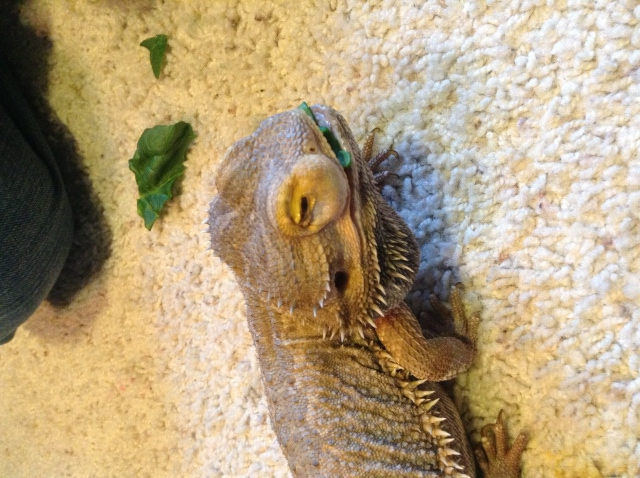 Rex hypovitaminosis A
Question
Rex Rex
This is the picture of hi
Rex hypovitaminosis A
Question
Rex Rex
This is the picture of hi
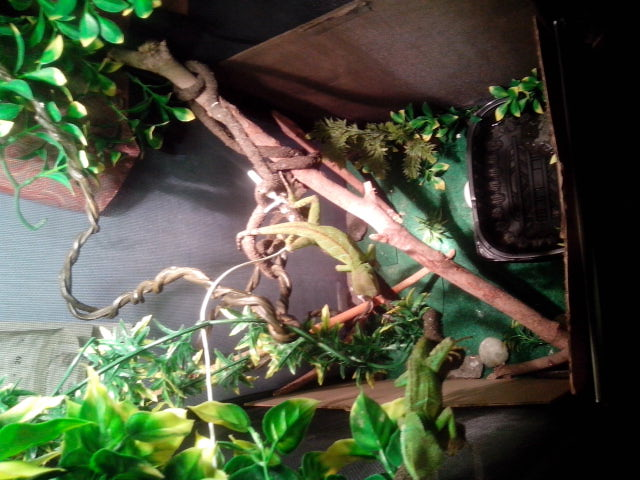 nose rub
Questionyoite and raikou new h
His mouth
nose rub
Questionyoite and raikou new h
His mouth
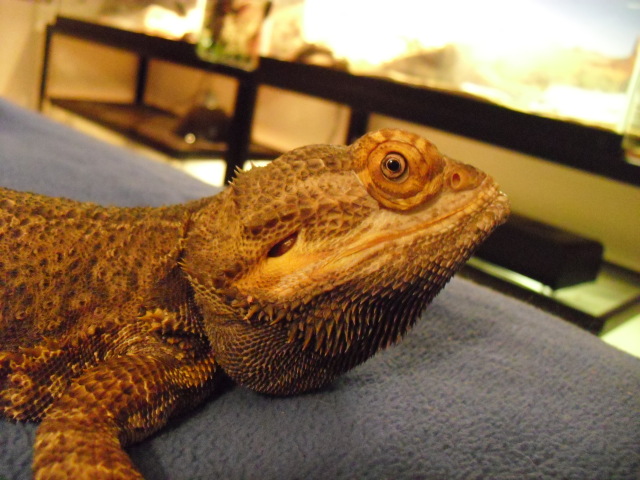 Bearded Dragon tympanic membrane (ear drum)
Question
Bearded Dragon
I noticed tonight that my drago
Bearded Dragon tympanic membrane (ear drum)
Question
Bearded Dragon
I noticed tonight that my drago
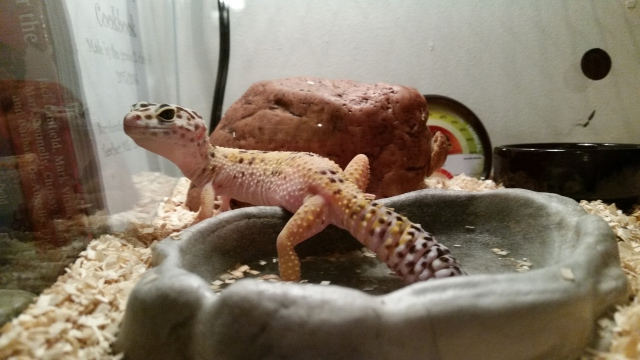 Leopard gecko possibly pregnant
QuestionQUESTION: Hello!
About a week ago I adopted a 2
Leopard gecko possibly pregnant
QuestionQUESTION: Hello!
About a week ago I adopted a 2
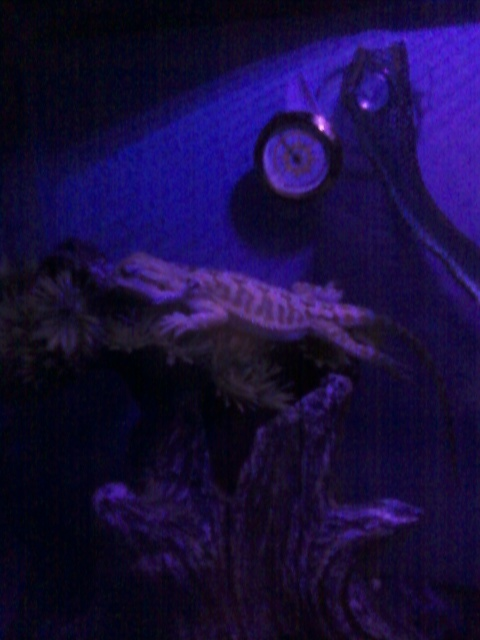 Walking strange
QuestionQUESTION: Hi Tracie,
We have a 9 month old bear
Walking strange
QuestionQUESTION: Hi Tracie,
We have a 9 month old bear